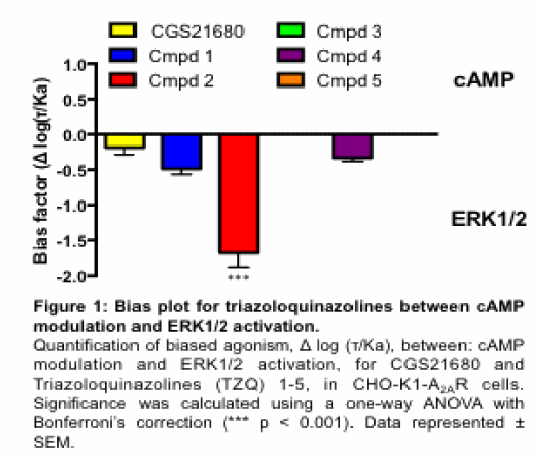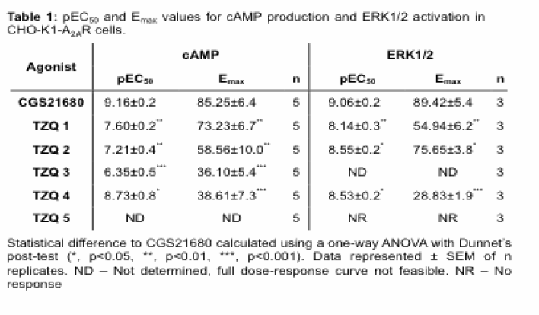| 120P London, UK Pharmacology 2017 |
Quantifying biased agonism of triazoloquinazolines: dual target A2AR/PDE10A ligands
Introduction: Compounds targeting both A2AR and PDE10A show particularly promising prospects for therapeutic intervention for Huntingdon disease (1, 2). We utilised an in silico docking strategy to identify A2AR agonists from a database of known PDE10A inhibitors (3), subsequently characterising identified target compounds in vitro.
Methods: Identified compounds were initially screened for receptor activation in yeast cells expressing the A1R, A2AR or A2BR (4). Active compounds were then validated in CHO-K1 cells, stably expressing the A2AR (CHO-K1-A2AR), for their ability to modulate cAMP production and activation of ERK1/2. We further quantified the extent of biased agonism between both pathways, as well as testing compounds in ST14a cells, a model for medium spiny neurones.
Results: Through screening test compounds in yeast we ascertain the ability of triazoloquinazolines to act as agonist of the Adenosine receptors (ARs). Through further validation in CHO-K1 cells expressing either the A2AR, or A3R, we identify 3 compounds to display selectivity for the A2AR and one to be a pan-AR agonist in terms of mediating cAMP production (Table 1). In addition we observe the ability of 3 compounds to mediate activation of ERK1/2 in an A2AR-dependent manner, in CHO-K1-A2AR cells (Table 1). Through quantifying the extent of biased agonism between these two pathways we discover that all agonists tested display bias towards activation of ERK1/2 (Figure 1) Further, we also identify the ability of our agonists to mediate A2AR dependent signalling in ST14a cells, a model for medium spiny neurones.


Conclusions: We have identified a series of triazoloquinazolines, a class of compound traditionally associated with being AR antagonists (5), to act as A2AR agonists. Further we have highlighted the ability of these compounds to mediate cAMP production and activate ERK1/2, showing them to be biased towards the activation of ERK1/2, a pathway that may promote proliferation (6) or cytoprotection (7).
References:
[1] Latini and Pedata (2001). J. Neurochem 79:463-84;
[2] Giampà et al (2009). Neurobiol. Dis. 34:450-56;
[3] Kehler et al (2011). Bioorg. Med. Chem. Lett. 21:3738-42;
[4] Knight et al (2016). J. Med. Chem. 59:947-64;
[5] Ongini et al (1999). Naunyn. Schmiedebergs. Arch. Pharmacol. 359:7-10;
[6] Jacques-Silva et al (2004). Oncology. 67:450-59;
[7] Baltos et al (2016). Biochem. Pharmacol. 99:101-12.

